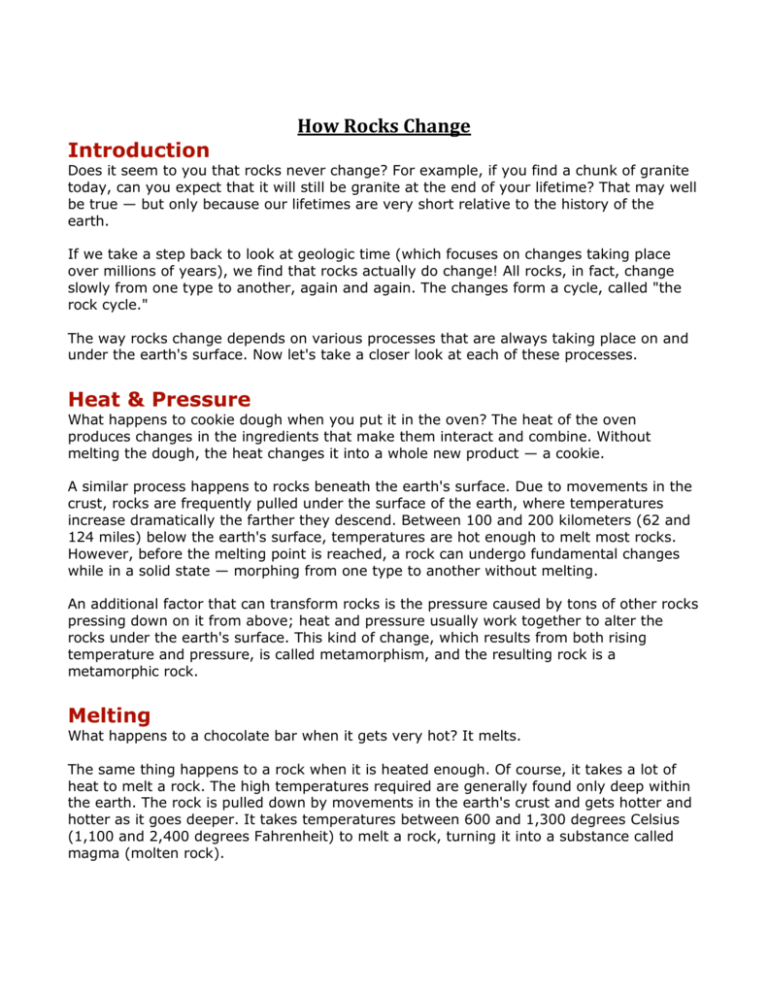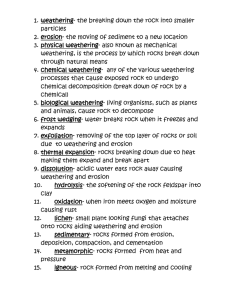How Rocks Change
advertisement

How Rocks Change Introduction Does it seem to you that rocks never change? For example, if you find a chunk of granite today, can you expect that it will still be granite at the end of your lifetime? That may well be true — but only because our lifetimes are very short relative to the history of the earth. If we take a step back to look at geologic time (which focuses on changes taking place over millions of years), we find that rocks actually do change! All rocks, in fact, change slowly from one type to another, again and again. The changes form a cycle, called "the rock cycle." The way rocks change depends on various processes that are always taking place on and under the earth's surface. Now let's take a closer look at each of these processes. Heat & Pressure What happens to cookie dough when you put it in the oven? The heat of the oven produces changes in the ingredients that make them interact and combine. Without melting the dough, the heat changes it into a whole new product — a cookie. A similar process happens to rocks beneath the earth's surface. Due to movements in the crust, rocks are frequently pulled under the surface of the earth, where temperatures increase dramatically the farther they descend. Between 100 and 200 kilometers (62 and 124 miles) below the earth's surface, temperatures are hot enough to melt most rocks. However, before the melting point is reached, a rock can undergo fundamental changes while in a solid state — morphing from one type to another without melting. An additional factor that can transform rocks is the pressure caused by tons of other rocks pressing down on it from above; heat and pressure usually work together to alter the rocks under the earth's surface. This kind of change, which results from both rising temperature and pressure, is called metamorphism, and the resulting rock is a metamorphic rock. Melting What happens to a chocolate bar when it gets very hot? It melts. The same thing happens to a rock when it is heated enough. Of course, it takes a lot of heat to melt a rock. The high temperatures required are generally found only deep within the earth. The rock is pulled down by movements in the earth's crust and gets hotter and hotter as it goes deeper. It takes temperatures between 600 and 1,300 degrees Celsius (1,100 and 2,400 degrees Fahrenheit) to melt a rock, turning it into a substance called magma (molten rock). Cooling What would you do to turn a melted chocolate bar back into a solid? You'd cool it by putting it into the refrigerator until it hardens. Similarly, liquid magma also turns into a solid — a rock — when it is cooled. Any rock that forms from the cooling of magma is an igneous rock. Magma that cools quickly forms one kind of igneous rock, and magma that cools slowly forms another kind. When magma rises from deep within the earth and explodes out of a volcano, it is called lava, and it cools quickly on the surface. Rock formed in this way is called extrusive igneous rock. It is extruded, or pushed, out of the earth's interior and cools outside of or very near the earth's surface. What if the magma doesn't erupt out of a volcano, but instead gets pushed slowly upward toward the earth's surface over hundreds, thousands, or even millions of years? This magma will also cool, but at a much slower rate than lava erupting from a volcano. The kind of rock formed in this way is called intrusive igneous rock. It intrudes, or pushes, into the earth's interior and cools beneath the surface. Weathering & Erosion What do dandelions rely on to separate their seeds, carry them, and deposit them elsewhere? The wind. All objects on the earth's surface are exposed to the wind, along with many other elements — water, the sun, and temperature changes. Over time, these factors wear objects down and break them apart. The resulting bits and pieces of material are called sediment. Sediment is then transported by wind and water, often ending up far from where it started. These processes of breakdown and transport due to exposure to the environment are called weathering and erosion. Weathering and erosion affect all rocks on the earth's surface. Compacting & Cementing What happens to a loose pile of garbage when it's put into a compactor? The squeezing of the machine produces a solid cube of compacted garbage. The same thing happens to sediment formed from the weathering and erosion of rock. Over time, sediment accumulates in oceans, lakes, and valleys, eventually building up in layers and weighing down the material underneath. This weight presses the sediment particles together, compacting them. Water passing through the spaces in between the particles helps to cement them together even more. This process of compacting and cementing sediment forms sedimentary rock.







